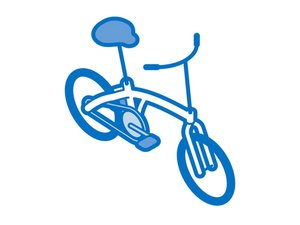Causes
What to do
If your bicycle is hard to pedal your gear ratio might be too high, and you can try downshifting. This means move your chain to a smaller front gear and a larger rear gear.
When this makes sense
If you are riding on more difficult terrain, especially steeper inclines, lower gear ratios can make things easier on your legs, though you may increase your heart rate or rate of breathing. Hence downshifting can also make sense if your legs are a little fatigued but your heart rate and breathing are not as impacted.
Why this works
For a given speed, a lower gear ratio means you will be moving your wheel less for the same rate of the turn of your pedals. This means less energy is required from your legs per pedal.
V-brakes (also known as direct-pull cantilever brakes) are one of the most common types of bike brakes. They’re operated via a cable that runs from one side of the brake and across the top, pulling the two halves together. The cable is attached to the brake levers on the handlebars on one end, and calipers attached to the brake pads on the other, so that when you squeeze the hand levers, the cable squeezes the two halves of the caliper/pads against the wheel, slowing down the bike. However, if brake alignment is off or the brake components are worn or dirty, it can impede the functioning of the bike even when the brakes are not in use.
To see if this is the issue, get off the bike and spin the wheels. They should not slow or stop suddenly. Check to see if the brake pads are rubbing against the wheel when the brake levers on the handle bars are not pulled in. You can either adjust the brake alignment and travel, or bias the wheel to one side. See the Brake Alignment Guide.
- Start by checking the tension and alignment. Loosen the brake pad bolt and tighten/loosen the tension adjustment screws, so that each brake pad is equally distant from the brake rim and the brake pads no longer rub against the wheel.
- If that doesn’t fix the issue, remove the brake caliper and inspect the brake pad. If the pad has worn down past the “wear line”, then it needs to be replaced. You might also need to clean and lubricate the parts as necessary before reattaching the caliper arms. If you make either of these adjustments, repeat Step 1 to make sure your brakes are aligned before putting your bike back into use.

- 30 - 45 minutesModerate
If the brakes are not rubbing but the wheel still feels stiff, your cones, or ball bearings, are probably adjusted too tight. Ball bearings reduce the friction caused by the rotating wheel by concentrating it on rolling bearings. Well-maintained ball bearings will help the wheel spin more freely and allow for an easier and smoother ride, whereas tight bearings will obviously impede movement. To see where the bike's cones are located and how to adjust them, see the Cone Adjustment Guide. Pack your patience—alignment is key for well-functioning cones, so it may take several tries to get right.

- 30 - 45 minutesDifficult
The crank, or chainset, is what connects the pedals to the wheels and bearings. A tight bottom bracket where the crank arms attach to the bike can also slow bike pedal movement. To see where the bike's crank arms are located and how to loosen (or replace them) see the Crank Arm Adjustment Guide.

- No estimateModerate

